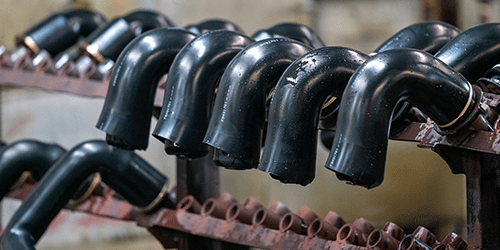The development of synthetic rubber coincided with the rapid advance of industrialization across the world. One of the earliest recorded developments of synthetic elastomers occurred in 1879, when the French chemist Gustave Bouchardat synthesized a form of rubber using isoprene. This process was later refined in 1909 by a German team of chemists with the German company Bayer. At this time, however, the development of synthetic rubber was considered something of a leisurely scientific curiosity.
The two world wars had driven home the need for synthetic rubbers and other such alternatives to natural rubber which could be as freely used. The nature of war and society had left people more mechanized and complex allowing for a revolution. It required materials such as rubbers that could last longer in the face of oils, chemicals, and high temperatures which were introduced during the war time. Natural rubber has many excellent attributes, but such resistance is not one of its strengths.
Developing synthetic rubber for eclectic use provided the opportunity to give the material specific desirable properties which could be embedded in the material. One such example is nitrile, which is a synthetic rubber material refined by German chemists between the two World Wars.
Nitrile
It was developed to provide a rubber with superior oil and grease resistance. Originally earmarked for war-time automotive use in vehicles like jeeps, tanks and planes, such types of synthetic rubber have become widely used in a range of applications.
Styrene Butadiene Rubber
SBR stands for Styrene Butadiene Rubber. It is a variation of nitrile rubber and was developed around the same time. Since it is a variation of nitrile rubber, SBR is sometimes designated as Buna-N, referring to the styrene compound used in its manufacture. It is a tough synthetic alternative to rubber which is often put to use in vehicle tires due to its robust and rugged nature. Also because of its excellent abrasion resistance qualities. Where natural rubber falters, a synthetic rubber such as SBR is designed to excel like in cases of tires for really hot environments that would harm the rubber. The durable nature of SBR allows it to be used in synthetic rubber products which require a higher degree of toughness.
EPDM
EPDM rubber is another popular synthetic rubber material that has a wide variety of uses. Generally it tends to come in a wide variety of variations. Despite that it’s common trait is an enhanced degree of resistance against outdoor weather conditions and harsh conditions that would affect things very differently. This synthetic rubber endures in the presence of moisture, ozone and UV rays, as well as a range of chemicals enabling its usage in space tech applications.
To book a consultation, please click here now.
